Fast Facts
- When: 4th May 2024
- Where: Churchill Downs, Louisville, Kentucky, USA
- Watch: At The Races
- Official Website: Kentucky Derby
The Kentucky Derby is one of North America’s biggest racing events. Usually held in May each year, the race is run at Churchill Downs in Kentucky and is known as ‘The Most Exciting Two Minutes in Sports’.
The Kentucky Derby ordinarily forms the first leg of the USA’s Triple Crown, along with the Preakness Stakes from Pimlico and the Belmont Stakes from Belmont Park. Much like the British Classics, these races are for three year old horses but unlike the UK races they are all run on dirt tracks and colts, geldings and fillies can take part in each.
At 1m 2f, the Kentucky Derby is the longest of the Triple Crown races, half a furlong further than the Preakness Stakes and a furlong further than the Belmont Stakes.
Below we will preview the latest running of this historic contest when the field has been confirmed and highlight the best betting offers available on the race.
Existing Customer Free Bets & Money Back Offers
Note: Offers will appear here nearer the event as and when they become available.
Stats Articles
Event Stats
Kentucky Derby Winners – 2000 to 2023
| Year | Horse (Draw) | Trainer | Jockey | Start Price | Going |
|---|---|---|---|---|---|
| 2023 | Mage (8) | Gustavo Delgado | Javier Castellano | 152/10 | Fast |
| 2022 | Rich Strike (20) | Eric Reed | Sonny Leon | 81/1 | Fast |
| 2021 | Medina Spirit (8) | Bob Baffert | John R Velazquez | 121/10 | Fast |
| 2020 | Authentic (15) | Bob Baffert | John R Velazquez | 84/10 | Fast |
| 2019 | Country House (19) | William Mott | Flavien Prat | 65/1 | Sloppy |
| 2018 | Justify (7) | Bob Baffert | Mike E Smith | 29/10 | Sloppy |
| 2017 | Always Dreaming (5) | Todd Pletcher | John R Velazquez | 47/10 | Fast |
| 2016 | Nyquist (13) | Doug O’Neill | Mario Gutierrez | 23/10 | Fast |
| 2015 | American Pharoah (15) | Bob Baffert | Victor Espinoza | 29/10 | Fast |
| 2014 | California Chrome (6) | Art Sherman | Victor Espinoza | 5/2 | Fast |
| 2013 | Orb (16) | Claude McGaughey | Joel Rosario | 11/2 | Sloppy |
| 2012 | I’ll Have Another (19) | Doug O’Neill | Mario Gutierrez | 153/10 | Fast |
| 2011 | Animal Kingdom (16) | H Graham Motion | John R Velzquez | 209/10 | Fast |
| 2010 | Super Saver (4) | Todd Pletcher | Calvin H Borel | 8/1 | Sloppy |
| 2009 | Mine That Bird (8) | Bennie L Woolley Jr | Calvin H Borel | 51/1 | Sloppy |
| 2008 | Big Brown (20) | Richard Dutrow Jr | Kent Desormeaux | 12/5 | Fast |
| 2007 | Street Sense (7) | Carl Nafzger | Calvin H Borel | 49/10 | Fast |
| 2006 | Barbaro (8) | Michael R Matz | Edgar S Prado | 61/10 | Fast |
| 2005 | Giacomo (10) | John Shirreffs | Mike E Smith | 50/1 | Fast |
| 2004 | Smarty Jones (15) | John C Servis | Stewart Elliot | 41/10 | Sloppy |
| 2003 | Funny Cide (6) | Barclay Tagg | Jose Santos | 128/10 | Fast |
| 2002 | War Emblem (5) | Bob Baffert | Victor Espinoza | 205/10 | Fast |
| 2001 | Monarchos (16) | John T Ward Jr | Jorge Chavez | 105/10 | Fast |
| 2000 | Fusaichi Pegasus (15) | Neil Drysdale | Kent Desormeaux | 5/2 | Fast |
About the Kentucky Derby
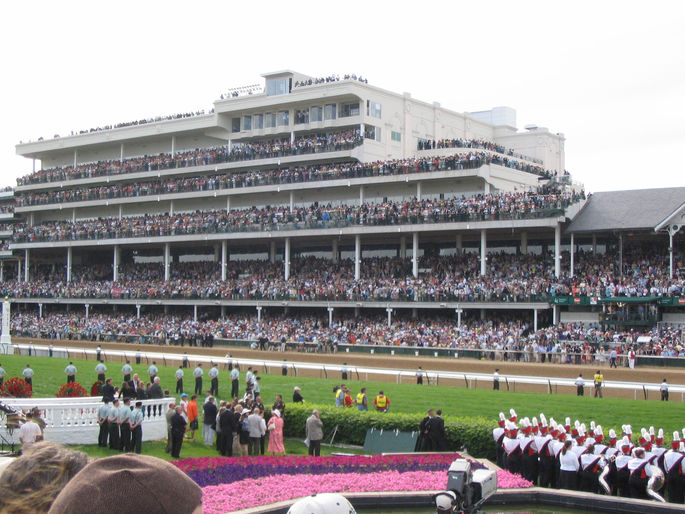
By Richard Hurt, flickr
The Kentucky Derby comes at the end of the appropriately named Kentucky Derby Festival. It is one of the most watched horse races anywhere in the world and was created in order to be America’s equivalent of the Derby raced at Epsom Racecourse in Surrey in the United Kingdom.
The race itself is only a small part of the fortnight known as the Kentucky Festival and is run in a reasonably straight-forward format.
Though the Kentucky Derby originally took place over the same distance as the Derby at Epsom, that was changed in 1896 when it was reduced down to a mile and a quarter. It is known as ‘the most exciting two minutes in sport’, in part thanks to the record of just shy of two minutes that was set by Secretariat in 1973.
Open to three-year-olds, it is run left-handed on a dirt track. Colts and geldings have a weight of one hundred and twenty-six pounds, whilst fillies are five pounds lighter. Both its speed and general standing in the American horse racing fraternity mean that it is one of the most watched races anywhere in the country, regularly seeing more spectators turn up to watch it than the other stake races.
The History the Kentucky Derby
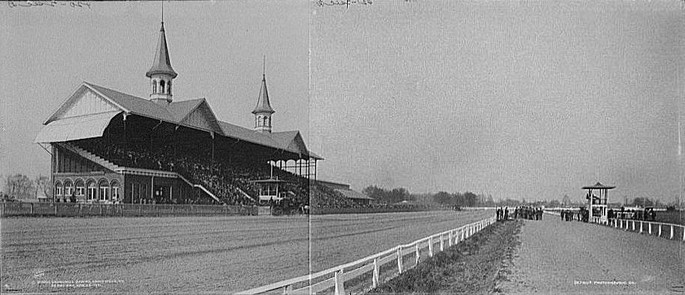
Churchill Downs 1901, Wikimedia Commons
In order to understand the history of the Kentucky Derby you first need to have some knowledge about the Derby that began at Surrey’s Epsom Racecourse in 1780. That was considered to be one of the most prestigious races in England at the time, so it’s little wonder that an American named Colonel Meriwether Lewis Clark, Jr. was taken to see the race when he was in England in 1872. The son of William Clark of the Lewis and Clark expedition, Lewis Clark Jr. enjoyed the race very much and was so was thrilled to be able to head to Longchamp afterwards and watch the Grand Prix de Paris, organised by the Jockey Club.
Such was the enjoyment that he took from the two races that he felt that his home state of Kentucky deserved a similar race of its own. He formed the Louisville Jockey Club with the intention of raising some money in order to build a horse racing arena on the outskirts of the city of Louisville. We’ll tell you about the track shortly, but the important information is that one was built and a race for three-year-olds was run over the same distance as the Epsom Derby on the seventeenth of May 1875. The Kentucky Derby was born and would go on to become one of the most prestigious races in America, so well-known that even British racing audiences, who weren’t short of events of their own like the Grand National and Cheltenham Gold Cup, would tune in to watch it every year.
Churchill Downs Racecourse
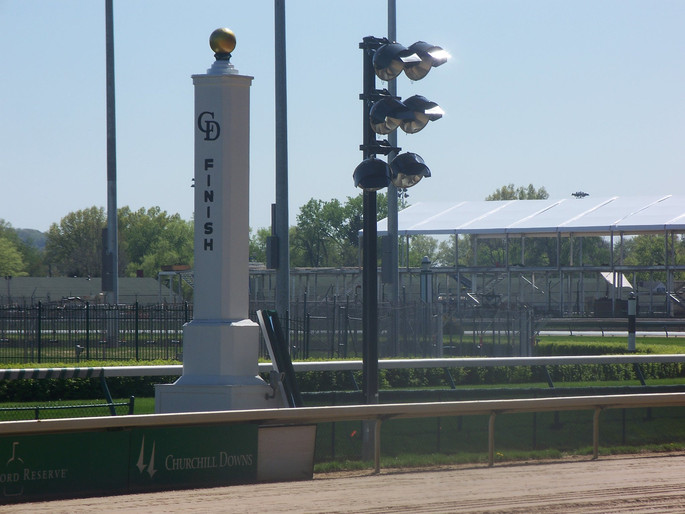
By Dylan Wolf, flickr
When Colonel Meriwether Lewis Clark, Jr. was looking for land on which to build his racecourse he became involved with John and Henry Churchill, who lent him an area of their own land for his use. Despite the closure of both Oakland and Woodland racecourse that had been based in Louisville prior to the opening of Churchill Downs, the stretch of land was seen as good for the purpose because it ran alongside the nearby railway tracks, meaning that horses would be able to be transported to the venue relatively easily.
Though they weren’t wrong in their confidence that it would be a success, it was clear by the middle of the 1890s that Clark Jr. was struggling to fund the project. As a result, it was sold to a syndicate being led by William E Applegate in 1894. Applegate had made his money by acting as a bookmaker and immediately set about instigating changes to the way that Churchill Downs was run. One of the key things that he did was to give the go-ahead for the building of a new grandstand, which had twin spires on its top. This would go on to become an iconic sight in American horse racing, being used as a symbol of the Kentucky Derby itself.
Despite having made his money as a bookie, Applegate didn’t enjoy the fact that his racecourse began to develop a reputation as a venue for mainly known for gambling. As a result, he made the decision in 1902 to turn over the general day-to-day running of the racecourse to the mayor of Louisville, Charles F. Grainger. He also brought in Colonel Matt Winn, who is widely considered to be responsible for the Kentucky Derby gaining the popularity that it boasts today. Indeed, it was thanks to Winn that the event actually turned a positive yield for the first time.
In modern times the racetrack has enjoyed numerous alterations. One of the most significant occurred after the turn of the millennium, when a $121 million refurbishment that included the demolition and rebuilding of the clubhouse took place. One of the controversial aspects of the refurbishment included the building of seventy-nine luxury suites, which block off the view of the Joseph Dominic Baldez designed spires from most angles.
Though the venue was known as Churchill Downs almost from the moment that it opened its doors for the first time in 1875, it didn’t take on the name officially until 1937. It was named in honour of the Churchills who had given Clark Jr. the land on which to build a racecourse after he’d formed the Louisville Jockey Club with the specific intention of doing just that.
The Race’s Place In The Triple Crown
Once the Kentucky Derby had gained the respect of the wider racing community in America the winning owners started to enter other prestigious races elsewhere in the States. Two such races were the Preakness Stakes and the Belmont Stakes, which raced in Baltimore’s Pimlico Race Course and the Belmont course in New York respectively.
US Triple Crown Races
| Race | Month | First Run | Location |
|---|---|---|---|
| Kentucky Derby | May | 1875 | Churchill Downs, Louisville, Kentucky |
| Preakness Stakes | May | 1873 | Pimlico, Baltimore, Maryland |
| Belmont Stakes | June | 1867 | Belmont Park, Elmont, New York |
Sir Barton became in the first horse to win all three races in the same year in 1919, leading to the three of gaining interest from the American public. That, combined with the large stakes that were up for grabs in each, meant that the idea of winning all three races became something for owners and jockeys to aspire to. In 1930 a sports writer called Charles Hatton wrote that a super horse might be able to win the ‘Triple Crown’, thereby associating the phrase with the three races.
The buzz around the idea started in the build-up to the Kentucky Derby, gripping the American public as the races grew closer. The entire enterprise became such a beloved thing that the schedule of the races was changed around to accommodate it. The Kentucky Derby was originally run in mid-May, but it was shifted to the first Saturday of May in order to make sure that it was there first of the Triple Crown races. That was in 1931 and ever since then it has been followed by the Preakness Stakes and then the Belmont Stakes.
Race Traditions
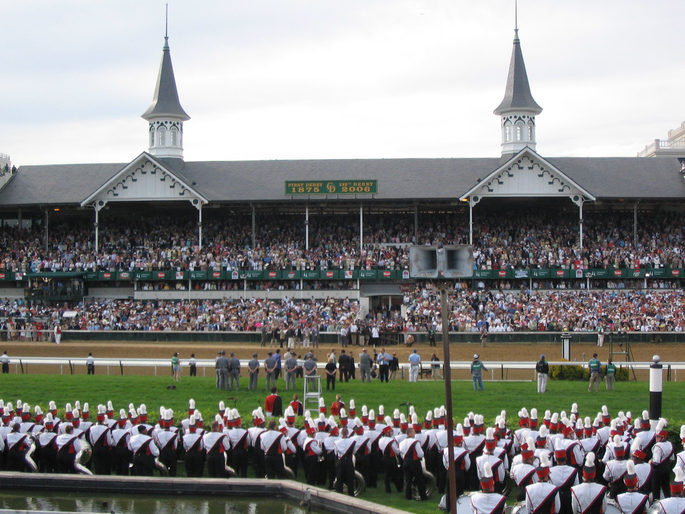
By Richard Hurt, flickr
The race was first run in 1875, so it’s not overly surprising that it has enjoyed an ever-increasing number of traditions since then. The reference to the ‘Run For The Rosé’ earlier is because the Kentucky Derby is also known as the ‘Run For The Roses’. That’s because the winner of the race is given a blanket which is made up of 554 red roses. That tradition was inadvertently started by a New York socialite named E. Berry Wall. Wall attested the race in 1883 and went to a party after the race where she handed roses to all of the ladies there. Clark Jr. was also in attendance and enjoyed it so much that decided to adopt the rose as the official flower of the race.
There are traditions that take place before the race gets underway, such as the Call to Post, which lets the jockeys know that it’s time to get their horses into position. They walk them in front of the grandstand to the sound of ‘My Old Kentucky Home’, which was written by Stephen Foster and is always played by the Cardinal Marching Band of the University of Louisville. The Paddock Judge, which is often a local or national celebrity, shouts ‘Riders Up!’ and the jockeys respond by climbing onto their horses.
The Kentucky Derby is somewhat unique in the world of horse racing on account of the fact that it has its own drink. The Mint Julep is an iced drink that consists of bourbon, mint and sugar. It gets its name on account of the fact that it is usually served in a julep cup of silver which has been frosted for coolness. Nowadays, of course, it’s prohibitively expensive for the one hundred thousand plus racegoers to have a silver julep, so the drink is served in a souvenir glass. The glass was first used in 1939 and is decorated with the different winners of the race.
Just as there is a drink of the race, there’s also a meal known as burgoo. It is a stew which is made up of beef, chicken, pork and vegetables. The richer members of society tend to go heavy on the Mint Juleps and lighter on the stew, watching the race from an area known as Millionaire’s Row. Those that prefer to watch the race from more run-of-the-mill surroundings will often crowd into the in-field, which is an area inside the track. It has always been popular, despite the fact that visitors would have been hard-pushed to see any of the race until the Jumbotron Screen was installed there in 2014.
The Kentucky Derby Festival
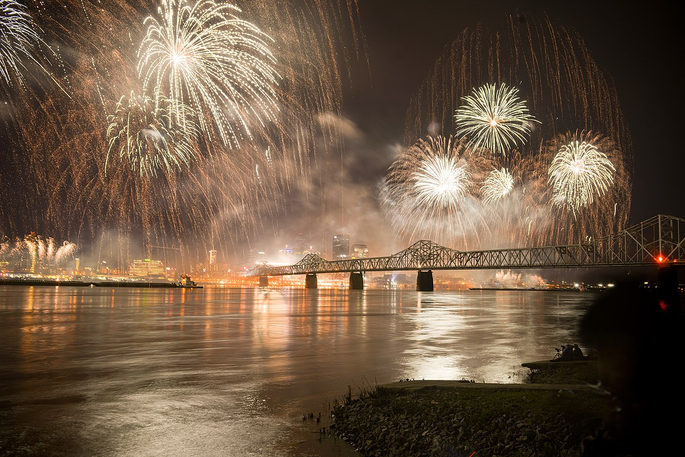
Thunder Over Louisville Fireworks by Aroun Kesavaraj, Wikimeda Commons
The race comes at the end of what is known as the Kentucky Derby Festival, which began in 1935 and is the Commonwealth of Kentucky’s largest single event. It first took place in 1935, lasting just two years before being scratched and then restarting in 1956.
Whilst the word ‘Festival’ when associated with horse racing in the UK is generally considered to be a period of top-class racing, the Americans take things far more literally. There is racing, of course, which why the Kentucky Derby is the culminating event of the entire fortnight, yet there are also a number of different things that occur during the weeks that surround the Derby. Some of the most prominent are as follows:
- Thunder Over Louisville. This is a fireworks display that is actually the largest that takes place in North America
- A pro-am golf tournament, which first began in 1974
- miniMarathon and Marathon. This is always the Saturday before the Derby and welcomes Track and Field’s biggest names
- Run For The Rosé, a fun race in which local waiters and waitresses run over an obstacle course with a tray full of glasses filled with rosé wine
- The Great Balloon Race
Interesting Facts
You already know that the race boasts a drink known as the Mint Julep and a meal called burgoo, but there are some other interesting facts that you might wish to read up on. Some of the key ones are as follows:
- Between 1914 and 1946 the race’s largest winning margin of eight lengths was achieved four times
- Eddie Arcaro and Bill Hartack have each won the race five times as jockeys, which is a record
- The most successful trainers at the Kentucky Derby are Bob Baffert and Ben A. Jones with six wins each though the Baffert trained Maximum security was first past the post in 2019 only to be disqualified
- The wonderfully named Calumet Farm boasts the most wins as an owner with eight
- Donerail won the Kentucky Derby with odds of 91/1 in 1913; the longest odds of any winner since the race began, the next biggest winning odds were Rich Strike at 81/1 in 2022
